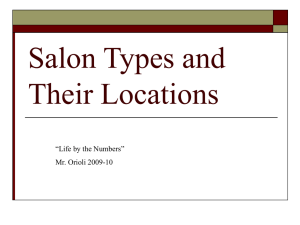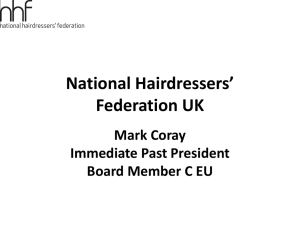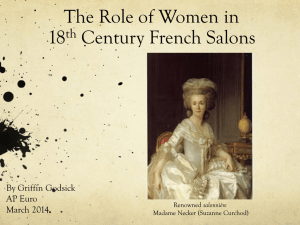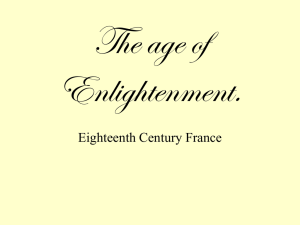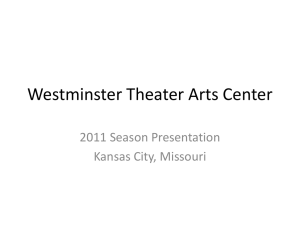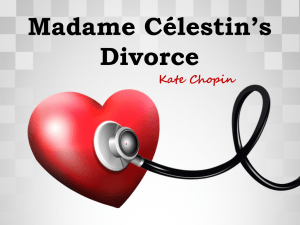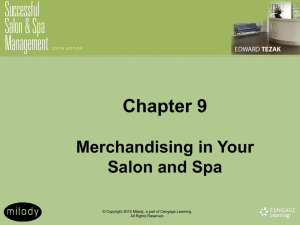Salons - William Osborne and Abbie Conant
advertisement
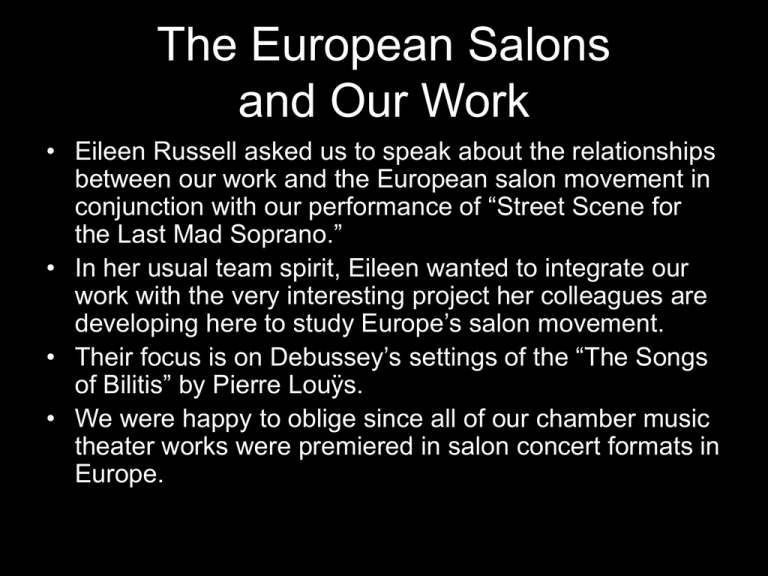
The European Salons and Our Work • Eileen Russell asked us to speak about the relationships between our work and the European salon movement in conjunction with our performance of “Street Scene for the Last Mad Soprano.” • In her usual team spirit, Eileen wanted to integrate our work with the very interesting project her colleagues are developing here to study Europe’s salon movement. • Their focus is on Debussey’s settings of the “The Songs of Bilitis” by Pierre Louÿs. • We were happy to oblige since all of our chamber music theater works were premiered in salon concert formats in Europe. Chamber Music Theater • We describe our works as chamber music theater. • By this we mean works in a chamber music format that strive to genuinely integrate music, text, and theater. • We also strive to use texts relevant to the modern world and have written many of them ourselves. • As you perhaps saw, they are not musicals nor operas, but a genre entirely of their own. What is a salon? • So the first question we need to answer is, what is a salon? • A salon is a social gathering of people, usually in a private residence, to share ideas and artistic expression. • In their most basic form, salons were often comprised of cultural elites meetings to amuse and educate each other. • In Europe, they have existed from about the 1580s to the modern day and played a central role in both the renaissance and the Age of Enlightenment. The Code • A code of behavior evolved in salons which had three basic tenants: Egalitarianism, Politeness, and Honor (or honesty) – these were similar to earlier codes of Italian chivalry. • The hostesses were most often wealthy bourgeois women. • The salons were not merely French. • There were similar movements in the coffee houses of England, and in the Tischgesellschaften in Germany. • And of course, non-European cultures also had forms of salon gatherings. • Here is a painting of a salon entitled “A reading of Molière” by Jean François de Troy from about 1728. • Note the large presence of women. The Age of Enlightenment • The salons were egalitarian: The many stratas of society were in theory allowed to meet in equality. • In practice, this meant that salons brought nobles and and elite bourgeois together -- they mixed social ranks and orders in opposition to court society. • The salons became an institution of the Enlightenment and served as a major channel of communication among intellectuals. • The Age of Enlightenment was one of the great epochs of European history and reached its apex in the 18th century. • It centered around the idea that humans could be rational and control their world through science and knowledge Role in Democracy • The Age of Enlightenment also formulated the political concepts that now define our modern democratic societies. • The United States, for example, was founded during the age of enlightenment and to this day shows both the Enlightment’s strengths and weaknesses. • Here is a painting entitled “A Reading in the Salon of Mme Geoffrin” from 1755. The Bourgeoisie • Through salons, the bourgeoisie developed intellectual, artistic, and moral discourse. • By meeting for intellectual discussion, the common people challenged the monopoly on the intellect that up until then had been held by the Church and State. • This discourse was, in effect, subversive, and became an important part of the development of early modern forms of democracy. • In a sense, common people also “profaned” art by deciding for themselves what it meant and how they would consume it. The Enlightened Project • It was during the Enlightenment that art also became more common as a bourgeois commodity. • The salons thus became cauldrons for progressive political, intellectual and cultural thought. • The salons also encouraged socializing between the sexes, which at the time was also very progressive. • In short, the salons encouraged intellectuals to engage in the project of enlightenment. • Here is a picture of Abbé Delille reciting his poem, La Conversation in the salon of Madame Geoffrin in Paris in 1812. Habermas and the Salon Movement • The most influential history of the salons is Jürgen Habermas' work, The Structural Transformation of the Public Sphere. • Habermas is a social historian and philosopher who teaches at the University of Frankfurt. • He was the first to link salons to the development of the Enlightenment and the evolution of democracy. • Almost all histories written since then have been in response to Habermas’ work. The salons and women. • Since most of the salons were hosted by women, the salons have become a focus of feminist scholarship. • Feminist historians note how women wielded power by controlling who was invited to participate and through moderating discussion. • The salon also became a way for women to pursue a form of higher education -- they exchanged ideas, received and gave criticism, read their own works and heard the works and ideas of other intellectuals. All-Male Universities • This was important, because it is only very recently that women have been allowed into many of our universities. • Princeton and Yale, for example, only opened their doors to women in 1969. The Blue Stockings • The so-called Blue Stockings became a manifestation of this social climate that created salons. • Bluestocking was derogatory term for an educated, intellectual woman. • They were stereotyped as being frumpy and the reference to blue stockings refers to the time when woolen worsted stockings were informal dress, as compared with formal, fashionable black silk stockings. • In about 1750, Mrs. Elizabeth Montagu (later called “the Queen of the Blues”) and her friends founded the first official bluestocking society in England. • They invited learned men to gather informally with them to talk about books, literature, art and architecture, as well as places and events that interested them. Ethnic diversity • In some cases, salons also allowed for ethnic diversity. • In Germany, some of the most famous salonnières were Jewish women such as Henriette Herz, Rahel Varnhagen, and Fanny Mendelssohn. • Here again we forget how recent these changes are. • It was only after the Second World War that many hotels in America dropped their regulations forbidding Jewish guests. Criticisms of feminist approach • It has also been noted that even though women were often the hosts of salons, they were seldom the featured thinkers or artists. • And their power did not extend far outside the salons. • Nevertheless, the salons were harbingers of the future. • Women are now a majority of the students in most universities, and the number of women professors is increasing rapidly. • The Bluestockings are taking over. Chopin and the salon. • By the 19th century, the salons had become more raffish, and often centered around painters and writers. • A very famous example of a salon artist was Frédéric Chopin. • After his Paris concert début in February 1832, Chopin realised that his light-handed keyboard technique was not optimal for large concert spaces. • Later that year he was introduced to the wealthy Rothschild banking family, whose patronage opened doors for him to other private salons. New genres for the salon • Chopin played frequently at salons, but even more, he preferred to play in his own Parisian apartment for small circles of friends. • New genres of music began to develop specifically for salons. • Chopin, for example, took the new salon genre of the nocturne, invented by Irish composer John Field, to a deeper level of sophistication. The Hotel Lambert Salon • One of the most famous salons Chopin frequented was regularly held at the Hôtel Lambert on the eastern tip of the Île Saint-Louis. • The Hotel Lambert was a politically oriented salon for Polish exiles. • Paris and the Hotel Lambert served as a safe harbor for Polish emigrants and royalists during the 1830s and 40s, who had been exiled from their country after an unsuccessful uprising against Russia. • The Hotel Lambert served as both a political think-tank and as a cultural venue for Polish artists. • Here is a painting entitled "Chopin's Polonaise - a Ball in Hôtel Lambert in Paris", by Teofil Kwiatkowski. Pauline Viardot • Pauline Viardot who lived from 1821to 1910 was another famous Parisian salonnière. • She was also a well-known mezzo-soprano. • Her music salon is credited for launching the careers of Camille Saint-Säens, Jules Massenet, Gabriel Fauré, and Charles Gounod. • All of these composers were direct precursors of Debussy and set the stage for the Songs of Bilitis. • Viardot is of special interest to Abbie and I, not only because she wrote over 100 Vocal compositions and15 Instrumental works, but most importantly because she wrote 5 works she called Salon Operas. Haí Lulí • Viardot also created songs based on the Mazurkas of Chopin . • Here is a recording of Cecilia Bartoli singing one entitled Haí Lulí. • It is about a woman waiting for her lover who does not appear. • http://www.youtube.com/watch?v=na1gMR cWI5U Weimar Classicism • Turning now to Germany, the later Enlightenment was strongly influenced by a group known as the Weimar Classicists. • It’s two most notable exponents were Goethe and Schiller. • The circle was not really neo-classical, but actually a rich combination of both classical and romantic impulses. • They strongly influenced later Germans such as Hegel, Schopenhauer, Nietzsche, and a host of romantic composers ranging from Schumann to Wagner. Weimar and Society • The Weimar circle saw a direct connection between art and political culture. • They formulated ideals that they hoped would create a socio-cultural reformation through aesthetic conceptions and values. • In the spirit of the Enlightenment, they celebrated organic wholeness and harmony in art. • They hoped education via art would produce a flourishing cultural milieu and help society to become “whole” in the process. • This philosophy strongly affects Germany’s cultural life to this day. Weimar’s relation to our work • In some respects the Weimarians are related to the work Abbie and I do. • Almost all of our works have a feminist character and study the creative identity of women in society. • Like the Weimar Circle of Schiller and Goethe, we too, even if on a more modest scale, are searching for new forms of social wholeness and harmony. • We feel this “wholeness” can be achieved through art by advocating the equality of women. • The relationship between art and society was always a hallmark of the salon movement and Abbie and I follow in that spirit. Fanny Mendelssohn and the Weimar Circle • Another famous salonnière was Fanny Mendelssohn. • She composed 466 pieces of music. • Her works were often played alongside her brother's in the salons held in the family home in Berlin. Weimar and Composers • The Mendelssohns, Schubert, Schuman, Chopin, and Liszt were all influenced by the values of the Weimar Classicists. • The Lieder of Schubert were often performed in German salons and reflected the the Classist’s sense of wholeness through art. • And like the piano music of Chopin, they became an embodiment of a kind of art specifically created for the salon. Criticisms of the Salon Movement • Critics of the salon movement suggest that they were not part of an oppositional public sphere. • In many respects, they were extensions of the values represented by the court societies they claimed to oppose. • In fact, most salons were not really egalitarian. • The bourgeois public sphere discriminated against women and the lower social strata of society. Even today • Even today we see that civic, professional, cultural, and philanthropic clubs are not accessible to many people. • And even today, these clubs provide the training ground and the power base of a stratum of bourgeois men – and perhaps a few token women. Egalitarianism as a mask • Another problem was that the participants of the salons only acted as if they were social and economic peers. • As with many of today’s private clubs, an ethos of egalitarianism served only as a mask for domination. • Equality is espoused on the condition that certain groups can be excluded. • As an example, the Phoenix Country Club in AZ maintains separate dining rooms for men and women. This segregation is a compromise to help them circumvent discrimination laws. Yale Club • Yale College did not admit women until 1969, so until then the Yale Club restricted its membership to men. • Wives even had to enter the club through a separate entrance, and were not allowed to have access to much of the clubhouse. Vienna Philharmonic • The Vienna Philharmonic, literally refers to itself as a Verein, which is the German word for club. • The Philharmonic only began admitting women in 1997 after I began writing articles about the orchestra that generated massive amounts of media coverage and very large international protests. • The Philharmonic has also traditionally excluded visible members of racial minorities, since they believe such individuals would destroy the ensemble’s image of Austrian authenticity. Ironies • The orchestra, however, refuses to hire a chief conductor, since they feel that would destroy the “egalitarianism” they have as a club -- an egalitarian all-male, all-white club. • In the European salon movement, such bracketing usually worked to the advantage of dominant groups in society and to the disadvantage of subordinates. Common Concerns? • A third problem is that there was no consensus about what defined the common concerns the salons addressed. • Who decides what a public issue is? • A commonly noted example is the historic shift in how domestic violence is viewed. • It was once primarily a matter of private concern, but is now generally accepted as something that affects our communities. • In fact, our performance tonight questions the biased viewpoints of male dominated art. • The Last Mad Soprano addresses a new domain of common concern about domestic abuse as represented in opera. The modern salon vs. the public institution. • Today, the salon has all but disappeared, at least in its traditional manifestations. • In the middle of the 20th century, there were still groups similar to salons in New York City’s intellectual life. • One example was the intellectual generalists centered around the Partisan Review. • These writers included luminaries such as Edmund Wilson, Paul Goodman, Harold Rosenberg, Lionel Trilling and Mary McCarthy. The Value of Discourse • It has been suggested that Susan Sontag was the last writer of that tradition. • These generalists shared a desire to exhibit intellectual range. • They found a way to pay attention to specific intellectual topics and yet comment on the larger cultural context in which those topics appeared. • The loss of these forms of thought created by intellectuals in salon-like atmospheres might be detrimental to our political, intellectual, and cultural lives. • (The Internet.) The Algonquin Round Table • In a lighter vein, the Algonquin Round Table was another form of a modern salon. • They were a group of New York writers, critics, actors and wits. They met for lunch each day at the Algonquin Hotel from 1919 until roughly 1929. At these luncheons they engaged in wisecracks, wordplay and witticisms. • Newspaper columns by Round Table members recorded the conversations and were disseminated across the country. Salons vs. the modern concert hall • In many respects, the modern concert hall suppresses some of the forms of intellectual discourse that were common in the salons. • The proscenium arch creates a wall between the quasi-deified artist and the public. • The intimate give and take of the salon is lost. • The movement of art toward being a commodity has created many problems. • On one hand, the mass media strove toward the lowest common denominator of the masses which inevitably made much artistic expression secondary to financial interests. • And in counter-reaction, many modernist artists simply disassociated themselves from the public in ways that ultimately caused their work to become a ghettoized area only for elite specialists. Connecting • The salon, by contrast, is entirely oriented to explorations of the new in an atmosphere that intimately connects the artist to his or her public. • The work of Schubert, Schumann, Chopin and Debussy all testify to the benefits of the salon format. Other advantages of the salon • The looser relationships of the salon also allow for more freedom of expression since they are free of many common forms of institutional restraints. • Salons could also help renew our appreciation for localized cultural identity and offer an alternative to the uniformity of the mass media. • Salons also place artistic expression in an atmosphere of discourse with the artists and audience instead of merely isolated, disempowered consumption. Socially meaningful • Through this kind of contact, the public gains a genuine sense of involvement with culture. • The salon could help re-establish the traditions of the public intellectual. • In this regard, salons could help reestablish a sense of communal discourse that could strengthen and protect democratic values in a world where those values are threatened by forces such as technology and globalization. The salon and chamber music theater • And now I will briefly address some specifics about salons and tonight’s program. • Five hundred years ago, a salon-like group known as the Florentine Camerata set the goal of genuinely integrating words, music and theater. • The Florentine Camerata was a group of humanists, musicians, poets and intellectuals in late Renaissance Florence who gathered under the patronage of Count Giovanni de' Bardi to discuss and guide trends in the arts, especially music and drama. • True to the salon format, they met at the house of Giovanni de' Bardi. Music and Drama • The Camerata’s apex of influence was between 1577 and 1582. • It can thus be seen as one of the very earliest salons. • As noted, one of their primary goals was to create a new genre that would completely integrate music and drama. • Unfortunately, they were not successful, and in the 500 years since, Western culture has still not solved the thorny problem of integrating music and drama on an equal basis. • Instead, Western culture moved toward opera where music is supreme, while the libretti and drama are secondary, if not verging on the ridiculous. Chamber Music Theater • Western culture has also been unable to create a successful form of chamber music theater -which was another of the Camerata’s goals. • Some of the greatest minds in Western culture tried to create chamber music theater but did not succeed. • These include Robert Schumann, Franz Liszt, and Richard Strauss. • They composed a genre of chamber music theater works that were called “melodramas.” Melodramas • In the 19th century, melodramas were a high art form. • It was only later that they represented dasterdly villians twirling mustaches in Victorian theaters. • The musical melodramas of the Romantic era were generally recitations of romantic poems with coloristic piano accompaniments – though Strauss accompanied his with an orchestra. Melodramas • The melodramas of Schumann and Liszt were written at the height of the Romantic era, and are so full of Sturm and Drang they can sound almost humorous to us today. • Composers also had few methods for using the voice to speak and sing in ways that were musical and yet able to create believable characters. • We will listen to a brief example by Schumann entitled Die Fluchtlinge. The performance is by Dietrich Fischer-Dieskau. Attempting the impossible • Fools that we are, Abbie and I jumped right into the problems of genuinely integrating music and drama, thinking we might be able to solve problems minds like Schumann, Liszt and Strauss couldn’t. • After all, there is always a kind of folly in artistic endeavor. • And we have some advantages they didn’t have. • With electronics we can create sonic worlds in a chamber format that would have been impossible for them. They relied only on the piano for their melodramas. Vocal techniques and notation systems • We also spent years studying and setting authors like Samuel Beckett so that we could learn to create texts that could be better integrated with music. • And we started from scratch, inventing and devloping new kinds of vocal techniques and singing suited to chamber music theater, and to integrating music and drama. • We also developed new ways of notating the rhythms of spoken texts and the rhythms of stage actions that allow the performer to be both musical and theatrical. A salon of our own • And finally, in our pursuit of music and drama, we even bought a house in Taos, NM, which is an artists colony where many progressive artists and intellectuals live. • Our house had a 1600 square foot wood working shop which we renovated into a studio and theater where we can perform our works for up to about 60 people in a salon atmosphere. • We have a complete lighting system and high quality quadraphonic sound system. • The space has a great accoustic. • We can perform our works in almost perfect detail for publics keenly interested in what we are doing. • We also present works by other artists. • And Abbie’s writing club also meets there once a week to read their latest work to each other. Street Scene • So now you’ve had a chance to see how far along we have gotten trying to solve the almost insurmountable problems of creating chamber music theater that integrates music and drama. • If this really were a salon, you could sit around drinking some wine and chat with us and other audience members about our efforts. • But at least here, we can still have a question and answer period if there is anyone who has any questions.
